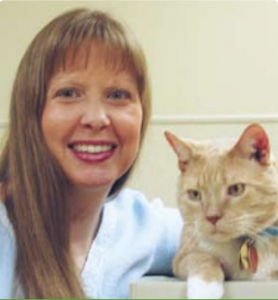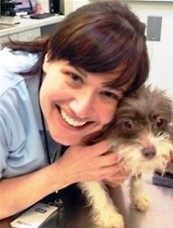Module 9: The Role of the Shelter Veterinarian
A Compassionate Field
Shelter veterinarians are probably as diverse as the shelters within which they work. Here are profiles about two veterinarians who work in shelters. As you read, look for evidence of their compassion toward pets and the people who care for them.
Compassionate Veterinarians

Dr. Brenda Griffin
I cried when my internship was over, but joined a small animal practice across town and continued to volunteer at the Boston shelter on my days off. The shelter staff embraced me and became my best friends—as well as my heroes for the brave work they did day after day. I wrote medical protocols for them and encouraged interns to come over from the hospital to help out in the shelter. I examined, vaccinated, and treated animals, and also assisted with euthanasia. There were more cats than I had ever seen—it was overwhelming, but the staff’s caring and courage touched the very core of my soul, and I knew why I had become a veterinarian. I learned so much from my friends there. Read more . . .

Dr. Cate McManus
Dallas Animal Services (DAS) wasn’t an obvious place for an idealist to land. Its live release percentage was in the 20s, and in 2011 the former shelter manager was indicted on felony animal cruelty charges amid public outcry over conditions at the agency. But that’s just where Dr. Cate McManus, one of the first veterinarians to complete Maddie’s Shelter Medicine Residency at the University of Florida’s College of Veterinary Medicine, wanted to be: somewhere she could make a difference. “I knew I wanted to go to a municipal shelter,” she said. “I knew there would be challenges, but I wanted to do something with all the things I’d learned. I wanted to put my boots on the ground and make a positive impact and save a lot of lives.” Read more . . .
Are compassionate veterinarians at risk?
“People who work in caring professions are often empathetic individuals and highly susceptible to compassion fatigue. In other words, the same qualities that make great veterinarians are the same qualities that can tank them. One’s capacity for empathy and compassion increases the risk for compassion fatigue. Veterinarians deal with death at five times the rate of any other healthcare profession, but we don’t offer five times the training to deal with death and morbidity.”
—Jennifer Brandt, PhD Licensed Clinical Social Worker OSU-CVM
“Many people in the veterinary profession try to muscle through compassion fatigue, but the symptoms mount until it becomes overwhelming. Everybody thinks compassion fatigue is you’re tired of giving—it’s not. It’s work-related trauma every day. Oftentimes the ones affected by compassion fatigue are the kind of people who drive themselves into the ground trying to make things better.”
—Patricia Smith, author of To Weep for a Stranger: Compassion Fatigue in Caregiving

